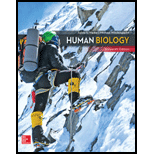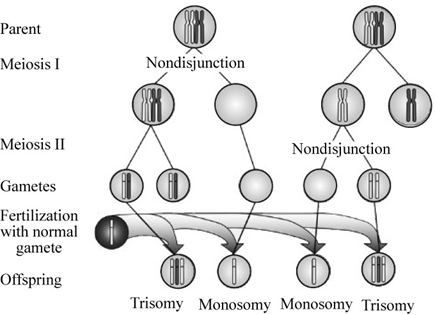
Human Biology
16th Edition
ISBN: 9781260482799
Author: Mader, Sylvia
Publisher: MCGRAW-HILL HIGHER EDUCATION
expand_more
expand_more
format_list_bulleted
Concept explainers
Question
Chapter 19.6, Problem 1LO
Summary Introduction
To explain:
The production of monosomy and trisomy chromosome conditions by the nondisjunction.
Introduction:
The condition, in which homologous chromosomes does not separates accurately during the division of cell is called nondisjunction. The nondisjunction can occur in three ways in the cells, failure in segregation of homologous chromosomes during mitosis, meiosis I (first meiotic division), and meiosis II (second meiotic division).
Pictorial representation:
The Fig. 1 represents the production of monosomy and trisomy chromosome conditions by nondisjunction are as follows:

Fig. 1: Represents the trisomy and monosomy occurring due to nondisjunction.
Expert Solution & Answer
Want to see the full answer?
Check out a sample textbook solution
Students have asked these similar questions
State the five functions of Globular Proteins, and give an example of a protein for each function.
Diagram of check cell under low power and high power
a couple in which the father has the a blood type and the mother has the o blood type produce an offspring with the o blood type, how does this happen? how could two functionally O parents produce an offspring that has the a blood type?
Chapter 19 Solutions
Human Biology
Ch. 19.1 - Distinguish between a chromosome and chromatin.Ch. 19.1 - Prob. 2LOCh. 19.1 - Prob. 3LOCh. 19.1 - Prob. 1CYPCh. 19.1 - Prob. 2CYPCh. 19.1 - Prob. 3CYPCh. 19.2 - Prob. 1LOCh. 19.2 - Prob. 2LOCh. 19.2 - Prob. 3LOCh. 19.2 - Describe the cell cycle, and list the locations of...
Ch. 19.2 - Prob. 2CYPCh. 19.2 - Prob. 3CYPCh. 19.2 - Summarize why external controls may be necessary...Ch. 19.3 - Prob. 1LOCh. 19.3 - Prob. 2LOCh. 19.3 - Prob. 3LOCh. 19.3 - Prob. 1CYPCh. 19.3 - Prob. 2CYPCh. 19.3 - Prob. 3CYPCh. 19.4 - Prob. 1LOCh. 19.4 - Prob. 2LOCh. 19.4 - Prob. 3LOCh. 19.4 - Prob. 1CYPCh. 19.4 - Explain how meiosis reduces the likelihood that...Ch. 19.4 - Prob. 3CYPCh. 19.4 - Compare and contrast the stages of oogenesis and...Ch. 19.5 - Prob. 1LOCh. 19.5 - Prob. 2LOCh. 19.5 - List the similarities and differences between...Ch. 19.5 - Prob. 2CYPCh. 19.5 - Prob. 3CYPCh. 19.6 - Prob. 1LOCh. 19.6 - Describe the causes and consequences of trisomy...Ch. 19.6 - Prob. 3LOCh. 19.6 - 4. Describe the effects of deletions,...Ch. 19.6 - Prob. 1BTSCh. 19.6 - Prob. 2BTSCh. 19.6 - Prob. 1CYPCh. 19.6 - Prob. 2CYPCh. 19.6 - Prob. 3CYPCh. 19.6 - Prob. 4CYPCh. 19 - Prob. 1ACh. 19 - 2. Which of the following is/are produced by the...Ch. 19 - 3. Label the drawing of the cell cycle: then list...Ch. 19 - 4. At which of the following checkpoints is the...Ch. 19 - ...Ch. 19 - ...Ch. 19 - a. metaphase
b....Ch. 19 - ...Ch. 19 - metaphase
prornetaphase
telophase
prophase c....Ch. 19 - 10. If a parent cell has a diploid number of 18...Ch. 19 - 11. If a parent cell has 22 chromosomes. the...Ch. 19 - 12. Crossing-over occurs between
sister chromatids...Ch. 19 - 13. Which of these helps provide genetic...Ch. 19 - 14. Polar bodies are produced during
DNA...Ch. 19 - 15. The pairing of homologous chromosomes occurs...Ch. 19 - 16. Sister chromatids separate during anaphase of...Ch. 19 - 17. Monosomy or trisomy occurs because...Ch. 19 - 18. A person with Klinefelter syndrome is and...Ch. 19 - Prob. 1TCCh. 19 - Prob. 2TCCh. 19 - Prob. 3TCCh. 19 - Prob. 4TC
Knowledge Booster
Learn more about
Need a deep-dive on the concept behind this application? Look no further. Learn more about this topic, biology and related others by exploring similar questions and additional content below.Similar questions
- What is the opening indicated by the pointer? (leaf x.s.) stomate guard cell lenticel intercellular space none of thesearrow_forwardIdentify the indicated tissue? (stem x.s.) parenchyma collenchyma sclerenchyma ○ xylem ○ phloem none of thesearrow_forwardWhere did this structure originate from? (Salix branch root) epidermis cortex endodermis pericycle vascular cylinderarrow_forward
- Identify the indicated tissue. (Tilia stem x.s.) parenchyma collenchyma sclerenchyma xylem phloem none of thesearrow_forwardIdentify the indicated structure. (Cucurbita stem l.s.) pit lenticel stomate tendril none of thesearrow_forwardIdentify the specific cell? (Zebrina leaf peel) vessel element sieve element companion cell tracheid guard cell subsidiary cell none of thesearrow_forward
- What type of cells flank the opening on either side? (leaf x.s.) vessel elements sieve elements companion cells tracheids guard cells none of thesearrow_forwardWhat specific cell is indicated. (Cucurbita stem I.s.) vessel element sieve element O companion cell tracheid guard cell none of thesearrow_forwardWhat specific cell is indicated? (Aristolochia stem x.s.) vessel element sieve element ○ companion cell O O O O O tracheid O guard cell none of thesearrow_forward
- Identify the tissue. parenchyma collenchyma sclerenchyma ○ xylem O phloem O none of thesearrow_forwardPlease answer q3arrow_forwardRespond to the following in a minimum of 175 words: How might CRISPR-Cas 9 be used in research or, eventually, therapeutically in patients? What are some potential ethical issues associated with using this technology? Do the advantages of using this technology outweigh the disadvantages (or vice versa)? Explain your position.arrow_forward
arrow_back_ios
SEE MORE QUESTIONS
arrow_forward_ios
Recommended textbooks for you
 Human Anatomy & Physiology (11th Edition)BiologyISBN:9780134580999Author:Elaine N. Marieb, Katja N. HoehnPublisher:PEARSON
Human Anatomy & Physiology (11th Edition)BiologyISBN:9780134580999Author:Elaine N. Marieb, Katja N. HoehnPublisher:PEARSON Biology 2eBiologyISBN:9781947172517Author:Matthew Douglas, Jung Choi, Mary Ann ClarkPublisher:OpenStax
Biology 2eBiologyISBN:9781947172517Author:Matthew Douglas, Jung Choi, Mary Ann ClarkPublisher:OpenStax Anatomy & PhysiologyBiologyISBN:9781259398629Author:McKinley, Michael P., O'loughlin, Valerie Dean, Bidle, Theresa StouterPublisher:Mcgraw Hill Education,
Anatomy & PhysiologyBiologyISBN:9781259398629Author:McKinley, Michael P., O'loughlin, Valerie Dean, Bidle, Theresa StouterPublisher:Mcgraw Hill Education, Molecular Biology of the Cell (Sixth Edition)BiologyISBN:9780815344322Author:Bruce Alberts, Alexander D. Johnson, Julian Lewis, David Morgan, Martin Raff, Keith Roberts, Peter WalterPublisher:W. W. Norton & Company
Molecular Biology of the Cell (Sixth Edition)BiologyISBN:9780815344322Author:Bruce Alberts, Alexander D. Johnson, Julian Lewis, David Morgan, Martin Raff, Keith Roberts, Peter WalterPublisher:W. W. Norton & Company Laboratory Manual For Human Anatomy & PhysiologyBiologyISBN:9781260159363Author:Martin, Terry R., Prentice-craver, CynthiaPublisher:McGraw-Hill Publishing Co.
Laboratory Manual For Human Anatomy & PhysiologyBiologyISBN:9781260159363Author:Martin, Terry R., Prentice-craver, CynthiaPublisher:McGraw-Hill Publishing Co. Inquiry Into Life (16th Edition)BiologyISBN:9781260231700Author:Sylvia S. Mader, Michael WindelspechtPublisher:McGraw Hill Education
Inquiry Into Life (16th Edition)BiologyISBN:9781260231700Author:Sylvia S. Mader, Michael WindelspechtPublisher:McGraw Hill Education

Human Anatomy & Physiology (11th Edition)
Biology
ISBN:9780134580999
Author:Elaine N. Marieb, Katja N. Hoehn
Publisher:PEARSON

Biology 2e
Biology
ISBN:9781947172517
Author:Matthew Douglas, Jung Choi, Mary Ann Clark
Publisher:OpenStax

Anatomy & Physiology
Biology
ISBN:9781259398629
Author:McKinley, Michael P., O'loughlin, Valerie Dean, Bidle, Theresa Stouter
Publisher:Mcgraw Hill Education,

Molecular Biology of the Cell (Sixth Edition)
Biology
ISBN:9780815344322
Author:Bruce Alberts, Alexander D. Johnson, Julian Lewis, David Morgan, Martin Raff, Keith Roberts, Peter Walter
Publisher:W. W. Norton & Company

Laboratory Manual For Human Anatomy & Physiology
Biology
ISBN:9781260159363
Author:Martin, Terry R., Prentice-craver, Cynthia
Publisher:McGraw-Hill Publishing Co.

Inquiry Into Life (16th Edition)
Biology
ISBN:9781260231700
Author:Sylvia S. Mader, Michael Windelspecht
Publisher:McGraw Hill Education
Mitochondrial mutations; Author: Useful Genetics;https://www.youtube.com/watch?v=GvgXe-3RJeU;License: CC-BY